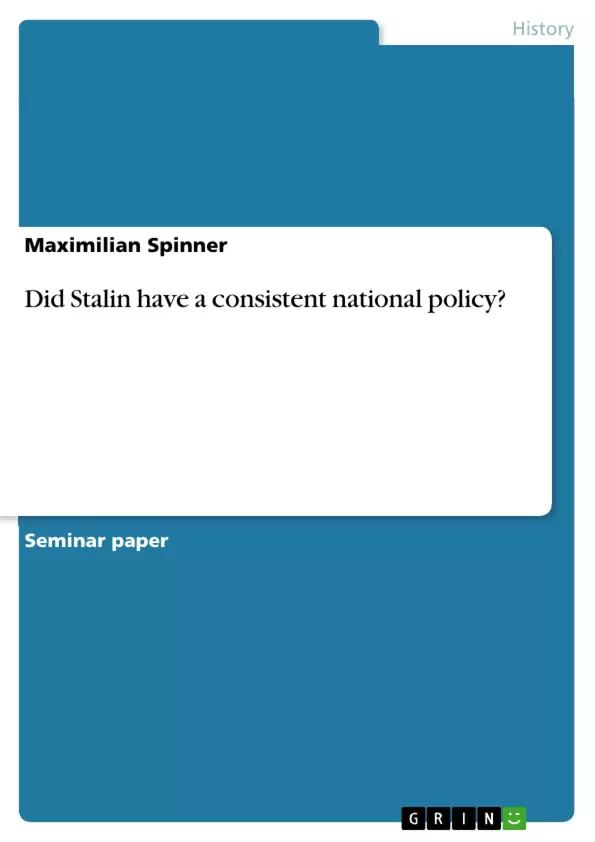This essay outlines the development of Stalin's policies on Soviet ethnic and national groups. Based on selected writings by Stalin and other original sources it shows when, how and why his approach to the national question changed over time.
Inhaltsverzeichnis (Table of Contents)
- Introduction
- Marxism and the National Question
- Stalin's pre-revolutionary works on the National Question
- From the Revolution towards the creation of the USSR – Stalin as the commissar of Narkomnats
- The Creation of Autonomous Republics
- The Promotion of National Cultures and Languages
- Korenizatsiia
- The Foundation of the USSR
- Stalin in Power: From Collectivization until the Great Patriotic War
- Collectivization and Industrialization
- The Great Purges and Rerussification
- The Great Patriotic war and Soviet patriotism
- Conclusion
Zielsetzung und Themenschwerpunkte (Objectives and Key Themes)
This essay examines Stalin's National Policy, exploring its key objectives, ideological underpinnings, and the extent to which Stalin adhered to a consistent strategy throughout his political career. The essay analyzes major developments and decisions, revealing an underlying rationale for Stalin's National Policy: the construction of a modern, centralized state.
- The evolution of Stalin's views on the national question.
- The impact of Marxist theory on Stalin's national policy.
- The role of language and culture in shaping national identity under Stalin's rule.
- The strategies employed by Stalin to build a centralized state.
- The influence of the Soviet experience on Stalin's national policy.
Zusammenfassung der Kapitel (Chapter Summaries)
The introduction outlines the essay's aim to provide a comprehensive overview of Stalin's National Policy, its objectives, and ideological foundations. It explores the extent to which Stalin followed a consistent strategy and identifies the underlying rationale for his policy, which was the creation of a powerful centralized state.
Chapter 2 explores the Marxist understanding of the national question and its application to Stalin's national policy. It discusses the Marxist perspective on nations as temporary phenomena and the belief that nationalism would give way to international class consciousness. It further explores the evolution of Marxist thought on national self-determination, highlighting Lenin's concept of the right to secession and its implications for the formation of a centralized state.
Chapter 3 examines Stalin's early writings on the national question, highlighting his initial opposition to national movements and his evolving views. It discusses his concept of a nation, which emphasizes the importance of a common territory, language, culture, and economic life. This chapter analyzes Stalin's preference for territorial autonomy over federalism and his belief that language repression was a significant driver of national aspirations.
Chapter 4 delves into Stalin's role as the commissar of Narkomnats (People's Commissariat for Nationalities Affairs) during the early years of the Soviet Union. It describes the complex environment inherited from the Tsarist regime and the Bolshevik efforts to win over smaller nations during the Civil War. The chapter explores the establishment and functions of Narkomnats, its role in promoting national identity within a unitary socialist state, and the significance of the Declaration of the Rights of the Toilers and Exploited People in shaping the early Soviet federation.
Schlüsselwörter (Keywords)
Key concepts and terms explored in this essay include Stalin's National Policy, Marxism and the national question, nation-building, Soviet nationalities policy, Narkomnats, cultural autonomy, self-determination, territorial autonomy, federalism, and the creation of a centralized state. The essay also examines concepts such as language repression, corenization, and the role of culture and identity in shaping national aspirations under Stalin's rule.
- Quote paper
- Maximilian Spinner (Author), 2002, Did Stalin have a consistent national policy?, Munich, GRIN Verlag, https://www.grin.com/document/13309



